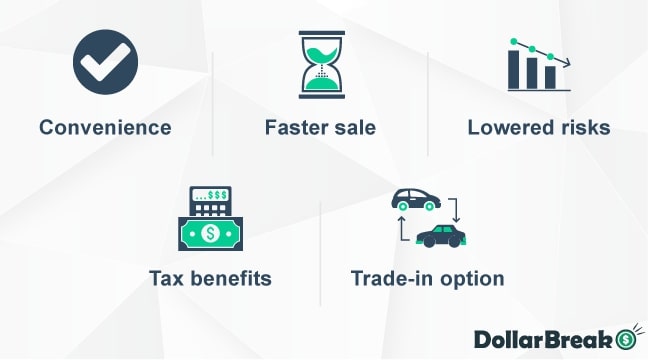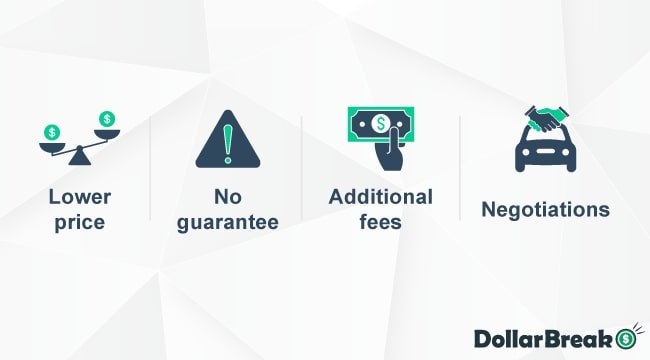Quick Answer:
Selling a car to a dealer involves several key steps to ensure a smooth and beneficial transaction.
Firstly, determine the market value of your car to understand its worth. Next, prepare your car by cleaning and fixing minor issues, and gather all necessary paperwork, including the title and service records.
Before finalizing the deal, compare offers from different dealers, negotiate to get the best price, and once satisfied, accept the offer. Finally, after the sale, remember to cancel your car’s insurance and inform the DMV about the change in ownership.
On average, selling a car to a dealer takes about 5 to 7 days, making it a favorable option if you’re looking to sell your car swiftly.
Key Takeaways:
- Understanding Market Value: Knowing your car’s market value is crucial for evaluating if the dealer’s offer is reasonable. Utilize resources like Kelley Blue Book to get an accurate estimate of your car’s worth.
- Exploring Multiple Dealers: Visiting various dealerships to obtain multiple offers is beneficial. It provides leverage in negotiations and helps in securing the best possible deal.
- Trading-In Advantages: When selling to a dealer, consider the trade-in option. It can potentially offer savings on sales tax and streamline the process of acquiring a new vehicle.
Best for Older & Damaged Cars

Buys used, damaged or junk cars
Free tow and no hidden fees
Pays by ACH trasfer or check
Top Pick for Junk Cars

Free, no-obligation cash offers
Offers free paperwork service
Pays on the spot upon pick up
How to Sell a Car to a Dealer:
1. Find Out Your Car’s Value
To estimate the value of your car at a dealership, using the Kelley Blue Book car value calculator is the most straightforward method. Enter details like your car’s make, model, year, mileage, overall condition, and any extra features. This will provide you with an approximate value for both trade-in and private sale.
Alternatively, for a professional assessment, consider taking your car to a local mechanic. While this service may cost around $100, it can offer valuable insights, especially when negotiating with dealers.
Additionally, knowing your car’s issues allows you to address minor problems before presenting it to the dealer.
2. Prepare Your Car
If your vehicle has small problems like burnt-out light bulbs or other issues that are easy and inexpensive to fix you should take care of them beforehand as it can increase both car’s value and aesthetic appeal.
Following this, give your car a thorough wash and clean the interior meticulously. Consider replacing floor mats or buying new air fresheners.
Remember to clear out all personal items. This will enhance the overall presentation of your vehicle.
3. Gather the Required Paperwork
Once you know your car’s value, you should make sure you have all the required paperwork necessary for performing a sale in your state.
Note that different states may have slightly different laws and require different paperwork.
The list of documentation you might be required to present:
- Certificate of Title (required in all states)
- Emissions test
- Bill of sale
4. Compare the offers
Once you have all the required documents ready, begin looking for car dealerships nearby. Aim to identify at least 5 or 6 dealerships where you might be interested in selling your car.
For instance, if you own a Toyota, reach out to several Toyota dealerships in your area. Similarly, if you have a Ford, get in touch with local Ford dealerships, and follow the same approach for other car brands.
Obtain quotes from various dealerships, allowing you to compare their offers and gain an advantage in negotiation discussions.
When visiting various dealers and obtaining quotes, explore different ways to sell your vehicle. For instance, certain dealers may provide options like:
- Trade-in: you trade in your old car and buy a new one from the same dealer.
- Straight sale: you sell the car to the dealer without buying a new car from them.
- Consignment: the dealership will display the car and handle the sale process for a fee or a percentage of the sale price.
| Selling Method | Pros | Cons |
|---|---|---|
| Trade-in | Convenient | Often get less money than selling privately |
| Outright sale | Can get more money than trade-in | Dealership may offer a lower price than private buyers |
| Consignment | Dealership handles the sale process | May have to pay a fee or percentage of the sale price |
5. Negotiate the Deal
Dealers aim to buy low and sell high, so they usually offer less than private buyers, but the transaction is much quicker and simpler.
Keeping this in mind, you should expect dealers to try to prolong negotiations as much as possible until you get tired and accept the offer. In some cases, it can extend to 4 hours or more.
Be prepared to negotiate, hold your position and don’t be afraid to walk away if you’re not happy with the offer.
Tips when negotiating with the dealer:
- Negotiate Based on Facts: Use your research on the car’s value to negotiate. If a dealer’s offer is too low, present your findings to justify a higher price.
- Avoid Emotional Attachment: Try to detach emotionally from your car. This helps in making rational decisions rather than emotional ones.
- Leverage Competing Offers: Informing the dealer about higher offers from other dealerships can be a strategic move. This often motivates them to improve their deal to retain you as a client.
6. Accept the Offer
Accepting the offer typically involves signing a bill of sale and other relevant documents. Ensure you have your car’s title and any necessary documents ready for the dealer’s review.
Before signing, thoroughly read and understand all the terms and conditions. The documentation should include details like your car’s make, model, year, VIN, mileage, purchase price, any trade-in value, and applicable fees or taxes.
Once you’re confident with the paperwork, sign it to finalize the sale. The dealer will pay you for your car and handle the remaining paperwork, such as transferring the title and notifying the DMV.
Additional tips for accepting the offer:
- Ensure all terms, including the price and trade-in value, are in writing.
- Don’t sign anything unclear to you; ask the dealer for clarifications.
- Be cautious of dealer add-ons like extended warranties or gap insurance. Only accept what you need.
- Don’t rush. Take your time to review everything thoroughly to ensure you’re comfortable with the deal.
7. Cancel Insurance and Notify the DMV
It’s crucial to complete the final administrative tasks: canceling your insurance and notifying the Department of Motor Vehicles (DMV).
Firstly, contact your insurance company to cancel or adjust your policy. It’s important to do this immediately to avoid paying for a car you no longer own. Moreover, you may be entitled to a refund of any prepaid premiums.
Secondly, inform the DMV of the sale. This step is essential as it releases you from legal responsibility for the vehicle. The process varies by state but typically involves submitting a notice of transfer and release of liability. This can often be done online or via mail.
Completing these steps ensures all legal and financial responsibilities are appropriately transferred to the new owner, safeguarding you from future liabilities related to the car.
Pros of Selling Car to Dealer
Selling a used car through a dealership is often seen as a convenient option. In fact, as reported by Statista, there were 18,263 light vehicle dealerships across the United States in 2021.
Nonetheless, it’s important to weigh the pros and cons before deciding to sell your car to a dealership.

- Convenience: A dealership associate handles all the necessary paperwork for you.
- Speed: Selling to a dealership is generally quicker than a private sale, although research and negotiation typically require at least 3-4 days on average.
- Reduced Risks: Dealing with a reputable dealership minimizes the chances of scams.
- Tax Advantages: In most states, trading in a vehicle can offer sales tax savings.
- Trade-In Option: If you’re looking to purchase a new vehicle immediately after the sale, considering a trade-in could be beneficial.
Cons of Selling Car to Dealer

- Reduced Price: Dealerships aim to profit, so they often offer less than what you might receive from a private sale.
- Uncertainty of Offer: If your car’s make, model, or condition isn’t in high demand, dealerships might not make an offer, anticipating difficulty in reselling it.
- Extra Costs: You may incur charges for car inspection or handling paperwork.
- Negotiation Challenges: Without strong negotiation skills, you risk accepting a financially less favorable offer.
How Much Can You Expect to Get?
Determining how much you can expect to receive when selling your car to a dealer involves several factors, such as the car’s make, model, year, condition, and mileage, which significantly influence its value.
Typically, dealers offer less than the private sale value as they need to make a profit when reselling. Market trends and demand for your specific car model also play a crucial role.
To get a realistic estimate, use reliable valuation tools like Kelley Blue Books’ car value calculator or Edmunds, which provide market-based pricing. Remember, dealer offers may vary, so it’s wise to get quotes from multiple dealerships.
Additionally, be aware that the dealer’s initial offer is often a starting point for negotiation. Factors like your car’s service history, any unique features, and your ability to negotiate can further impact the final offer you receive from a dealer.
Tips for Selling a Car to Dealer
Selling a car to a dealer requires a different approach compared to a private sale. Here are some tips to help you navigate the process effectively:
- Understand the Trade-In Option: If you’re planning to buy a new car, understand how the trade-in value would affect the deal. Sometimes, dealers offer a better trade-in value as part of a new car purchase deal.
- Know Your Bottom Line: Decide the minimum offer you’re willing to accept, and be prepared to walk away if the dealer cannot meet it.
- Consider Online Car Buying Services: Online services might offer a competitive price for your car. Explore options like Peddle, Wheelzy, or CarBrain.
- Beware of Upselling: During the process, a dealer might try to upsell additional services or warranties, especially if you’re buying a new car. Be clear about what you need and stick to your budget.
Can I Sell a Car to a Dealer Without Buying a New One?
Indeed, it’s possible to sell your car to a dealer without purchasing a new one. Dealerships source used cars from various places, including private sellers, auctions, and car rental companies, as they require a consistent inventory of used cars.
Selling your car to a dealership can be an effective way to dispose of a vehicle you no longer want or need. This method is also relatively straightforward and hassle-free. The dealership takes care of all the paperwork and logistics involved in the sale.
Can I Sell a Financed Car to a Dealer?
Yes, selling a financed car to a dealer is possible, but it requires additional steps compared to selling a fully owned car. Here’s a breakdown of the process:
- Loan Balance Check: Begin by determining the remaining balance on your car loan. This information can be obtained from your lender.
- Car Valuation: Establish the current value of your car. You can use online valuation tools or get a quote from the dealer to see if your car’s value is higher or lower than the loan balance.
- Equity Assessment:
- Positive Equity: If the car’s value exceeds the loan balance, you can sell the car, clear the loan, and keep the surplus.
- Negative Equity: If the car is valued at less than the loan balance, you’ll need to cover the shortfall between the sale price and the loan amount.
- Dealer’s Involvement in Loan Payoff: Once you decide to sell to a dealer, they often handle paying off your car loan. Ensure the dealer pays the owed amount directly to the lender.
- Completing the Sale: In cases of negative equity, you’ll need to pay the difference to the dealer. For positive equity, the dealer will pay off the loan and give you the remaining funds.
- Paperwork and Finalization: Complete all required paperwork to transfer ownership and responsibility to the dealer.
- Loan Closure Confirmation: After the dealer settles the loan, confirm with your lender that the loan is fully paid off and there are no remaining balances.
Best Mileage to Sell a Car?
Keeping your car for an extended period can be cost-effective since its depreciation slows down over time. However, it’s best mileage to sell your car is right before it reaches 100,000 or 200,000 miles.
Beyond these milestones, selling becomes more challenging, and the car may require costly repairs due to its age and usage.





